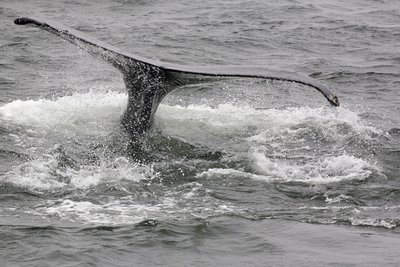
1. You are totally dependent on what the whales choose to do. You'll probably get some good tail shots, spouts, and dorsal fin shots - anything else - and you're REALLY lucky!
2. You're on a moving boat - level horizons - forget about it! That is what Photoshop is for. (Well, in reality, I do pay attention, and do slip the lens around on its mount to "try" to get a level horizong, but the boat is moving in all directions - it is futile to expect every shot to be level.)
3. You have a very short window between seeing the whale surfacing, locking your focus and getting your shot. The humpbacks in Massachusetts were easy because of the way they were feeding. You would see the feeding bubble and know you were going to get a head shot. One of my tricks for getting focus quickly is to focus on the ocean ahead of me regularly so if a whale shows, I'm already close to having the focus. Whle I've also tried to focus in as the boat races to get close to spounting whales, that also is fairly futile- the boat is usually moving too fast to get a good focus lock..
4. Shoot shutter priority, but continually check your histogram, because the lighting changes and sometimes you need more exposure others less - fully automatic won't work. Because, the boat and the whale are in motion, the spot you are focusing and metering on can change from shot to shot causing some shots to be better exposed than others.
5. Whale watching tours generally operate on their timetable. The one out of Ventura leaves at 9:00, but it takes an hour or more to reach the feeding grounds. While it is possible to charter boats, that is usually too expensive for my budget. Therefore, you are usually shooting outside the optimum time of day. My cloudy day actually worked in my favor this time. While the photos are colorless for the most part, naturally black and white, the exposure was much easier. The humpbacks were black, with only the barnacles on the tales showing color. The seals' and the sea kelp also provided color against the gray sky and water. But it also had less light than on a sunny day during optimum shooting times.
No comments:
Post a Comment